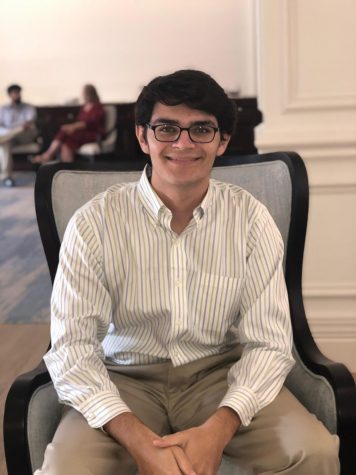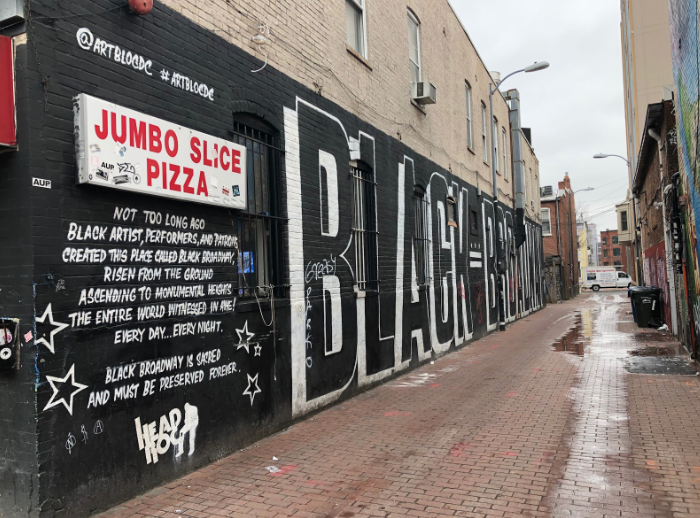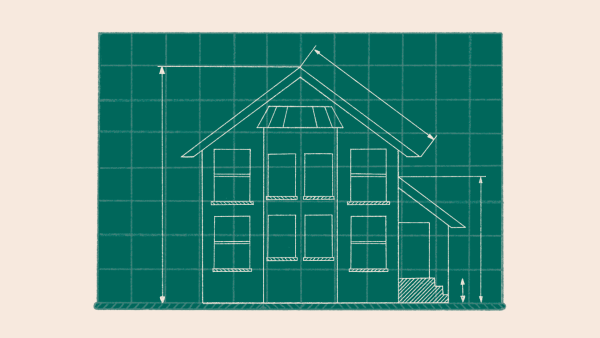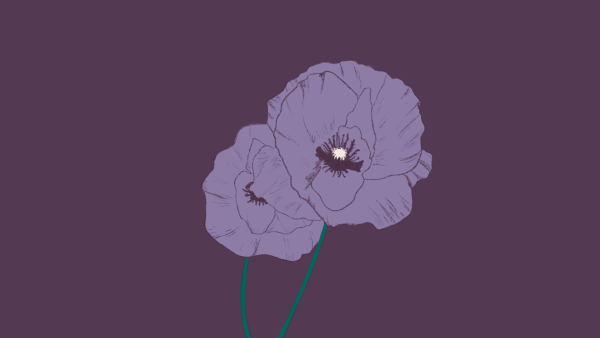Writing on our walls: Division in the Public Artist Community
Cory Stowers is the art director of Art B.L.O.C DC, an organization that is contracted by neighborhoods and businesses to create public art in Washington. Stowers and ART B.L.O.C DC painted a mural at the intersection of 14th and U street, an area known as Black Broadway. However, they quickly ran into a problem.
“I got permission from the business owner, but the building owner didn’t know anything about [the mural],” Stowers said. “As the team was finishing, I got a call from [the building owner] saying she didn’t know what Black Broadway meant and if the tenants of the jazz club in the building would be offended by it.”
Stowers agreed that if the owners of the jazz club, another tenant in the building, or the building owner were against the mural, Art B.L.O.C DC would take it down right away. He never got a callback.
The mural “Black Broadway” consists of a blacked-out wall and white letters honoring the area’s history of showcasing black artists, performers, and patrons. The final line reads: “Black Broadway is sacred and must be preserved forever.” Now, it serves to highlight historical context of the area’s civil rights history and is a widely recognized symbol of the neighborhood.
Although Art B.L.O.C DC is contracted for public murals by the District and private businesses, most of its members are traditional graffiti artists part of a crew called the Double Down Kings, which was established in 1994 with Stowers as its president.
The word graffiti is synonymous with vandalism and is a sign of urban decay. To many urban dwellers, any street art is ‘just graffiti’. However, the public art community, as it’s called, is made up of graffiti, street, or fine artists. From an outside perspective, there may seem to be a lack of division between these categories, but artists within the community are quick to distinguish their differences.
To Stowers, graffiti, compared to other forms of public art, represents individuals.
“Graffiti is strictly about the author because the artwork itself is the signature of the artists, not necessarily an image or something of that nature,” Stowers said. “For the most part, the direct focus of graffiti is a kind of self-promotion.”
Other members of the public art community, such as Mazi Mutafa, do not necessarily agree on this definition.

Mutafa, co-founder of the hip-hop non-profit organization Words Beats & Life, said the largest differences between graffiti and street art are the different techniques the artists use. The work of graffiti artists can be recognized by the use of aerosol paints, usually in letter based designs, while street art is seen in stencil and sticker work, according to Mutafa. He also identifies a clear gendering of these terms.
“When I think street artists, I usually think women,” Mutafa said. “When I think graffiti artists, I usually think men. Of course, there are women who are graffiti writers and men who are street artists, but I think in terms of popular media and who they call street artists and who they call graffiti artists, there definitely is a gender dynamic.”
Although there is disagreement within the public art community as to what qualifies as graffiti or street art, many artists do not confine themselves to only one art form.
Even though Stowers identifies himself as a graffiti artist, much of the work he does through Art B.L.O.C. D.C. are public murals rather than graffiti. For him, pursuing public art opens a new audience to interact with, an impact that is not accessible through graffiti.
“It allows us to have conversations in the public forum about public art, as opposed to graffiti, which is where most of us get our start,” Stowers said.
Mutafa’s non-profit not only creates public art but also coordinates art programming for youth in the District. The programming focuses on drawing connections between graffiti, street art, and fine art, and teaches students how to make public art of their own.
“We want our students to have access to all three kinds of languages,” Mutafa said. “Our artists don’t limit themselves to one discipline, and neither do we as an organization.”
Alex Goldstein is the director of The Fridge, an independent art gallery located near Eastern Market in southeast Washington. His interest in art began at the age of ten, seeing artist lofts in New York which encouraged him to create his own graffiti. He considers The Fridge to be a place where those who started with graffiti and vandalism art, like him, can pursue a new seriousness regarding their craft.
“The gallery has been a channel for many artists that have been doing illegal art for years to feel legit,” Goldstein said.
Goldstein’s artistic beginnings in graffiti have led him to a career of impactful work and one of the only successful independent galleries left in the District. He believes that other artists can also begin their career in graffiti or other “illegal” art, but can lead to bigger, legal projects.
Goldstein and The Fridge work to highlight up-and-coming local artists by hosting exhibits featuring artists ranging from Washington-based fine artist Joel Vincii to the DC Street Sticker Expo, which is made up of stickers sent in from 500 to 700 artists worldwide. The 10-year-old gallery has launched around 1,000 artistic careers.
“Now, many of them are very successful muralists. Street art is the top of current modern art,” Goldstein said.
The Fridge has even featured Borf, a street artist originating from the District, in his first solo show. He has now gone on to collaborate in projects with world-renowned street artist Banksy.
Stowers and Art B.L.O.C. DC, on the other hand, believe their art’s purpose is to provide contextual identity and history for areas of Washington, especially those targeted by gentrification and displacement. They create murals such as Black Broadway to reassure the original community of their importance and educate visitors unaware of the neighborhood’s history.
“A wall or alley that once didn’t have any sort of public value all of a sudden becomes a point of gathering and attention for the community,” Stowers said. “It creates a space, or recreates the space and in an aspect that adds value to the community.”
Despite all these differences, there is one thing that the public art community seems to agree on: art’s power lies in its ability to start conversations.
Goldstein is hoping to create issue-based exhibits in his gallery that will highlight themes such as mental illness and substance abuse. He hopes it will lift the silence surrounding these problems caused by stigma.
“It’s going to be a vehicle for conversation between artists and viewers,” Goldstein said.
For Mutafa and Words Beats & Life, artistic efforts should not only look to start a dialogue between artists and the public, but also between different public artists who have distanced themselves from each other.
“More and more we’re trying to work against efforts to separate artistic communities in hip hop, and really try to get people to collaborate more together,” Mutafa said. “We believe that what will come with that is more beautiful, collaborative, impactful work.”

Kavi Farr (he/him/his) an SIS junior from Massachusetts who loves graphic design, photography, and taking down the ruling class.
Fun fact: I have...







